
Education is an important aspect of what eye care professionals do when interacting with patients. Yet many seem to struggle with this fundamental aspect of delivering quality care. Perhaps one reason is we needlessly overcomplicate the approach to delivering education by overestimating what our patients know when they come through our office doors.
BACK TO BASICS
A few years ago, as I surveyed the landscape of online video-based ocular health resources that I could provide my patients, I quickly realized there was a disconcerting lack of quality educational videos available for public consumption. I recently decided to do something about that by starting the website Introeyes.com (see next page). My vision was that our videos would house good, basic, elementary education about the eye and how the services of qualified and trained eye care professionals can be beneficial. I viewed Introeyes.com as a chance to raise the level of general awareness among the public about our field and professions. My hope was that, when patients come to our clinics, we could start from a basic level of understanding and build upon it.
INTROEYES.COM

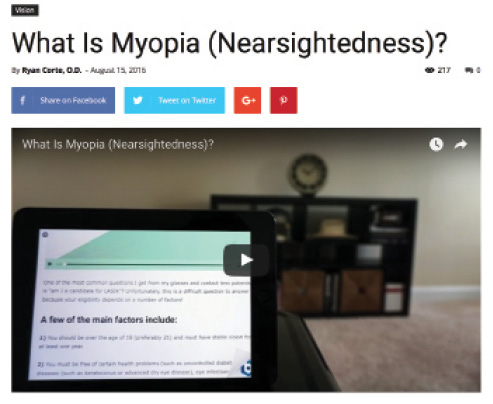
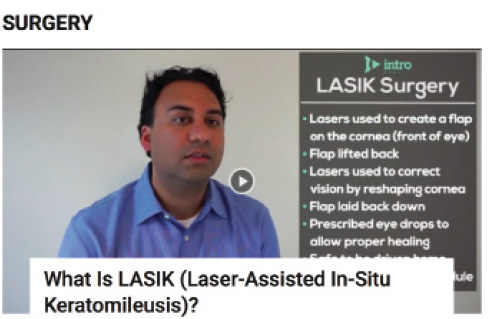
After recruiting a team of opticians, optometrists, and ophthalmologists, we have finally launched Introeyes.com. Although there are other websites that do an excellent job of providing the same kinds of information we do (see Helpful Online Sources for Patient Education), we have chosen to focus on offering concise, well-produced videos that focus on the very basics of eye care. I am particularly proud of the results, and I hope my colleagues will find the site useful.
A STRUGGLE TO EDUCATE
I get the sense that many of my colleagues struggle with educating patients. One of the themes I hear often when I talk to my peers is that they cannot seem to get patients to really understand the information they are trying to convey. I do not necessarily fault those who have difficulty with this aspect of patient care; after all, the medical conditions we describe can sometimes be the result of complex pathophysiologic mechanisms, and it has taken us years of training to understand the nature of the ocular diseases and disorders we seek to treat.
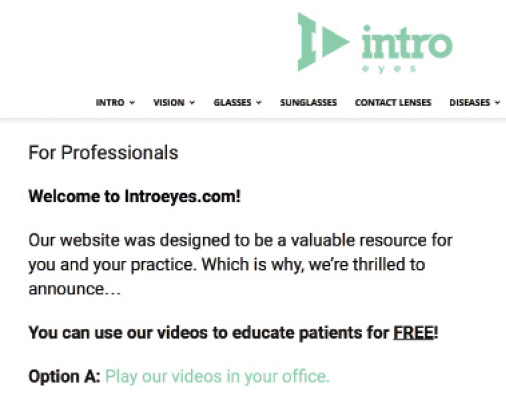
Introeyes.com also offers resources for physicians.
I think there is a connection between the lack of information available for public consumption and the problems my peers have explaining things to their patients. That is, there is a shortage of easily relatable and fundamental information available in the market. Therefore, when patients come into our offices, they may be starting from a point of zero understanding. Worse, they sometimes come to our offices with misinformation digested from the internet.
Also, I sometimes wonder if many eye care practitioners are afraid to talk on a basic level to patients, and instead they load their educational sessions with jargon to make things sound more official. When we talk to patients, we probably tend to revert to the language we use when conversing with colleagues because we are comfortable with the terminology. The thing is some of this material is quite complex. The average patient needs this information conveyed at an elementary educational level. Even a patient with a doctorate in engineering could easily misunderstand the mechanics of accommodation and presbyopia.
It is not at all insulting to start basic, to “read” patients for their level of comprehension, and to ask during a conversation whether they want more details. In fact, quite the opposite: Starting by assuming the patient knows nothing and ramping up the details as appropriate respects the patient’s time and provides great service in the process.
STEPWISE TEAM APPROACH TO EDUCATION
Another reason eye care professionals may struggle with patient education is if they feel a bit overwhelmed trying to cover all the information their patients may need. Instead of taking all this responsibility on oneself, it can be more effective to educate patients using a team approach. In our office, each member of our eye care team is responsible for educating patients about his or her own particular focus, as well as providing general information about what the next steps may be.
For example, patients start by filling out the standard review of symptoms form when they get to our office. Our technicians review these forms to obtain the chief complaint, but they also key in on information patients provide about their visual symptoms; each of those symptoms may be actionable information that prompts follow-through if the technician is prepared ahead of time. For example, if a patient reports that he or she has a cataract, information is provided about services we offer in our office, but the technician will also introduce the possibility of a referral for surgical evaluation.
HELPFUL ONLINE SOURCES FOR PATIENT EDUCATION
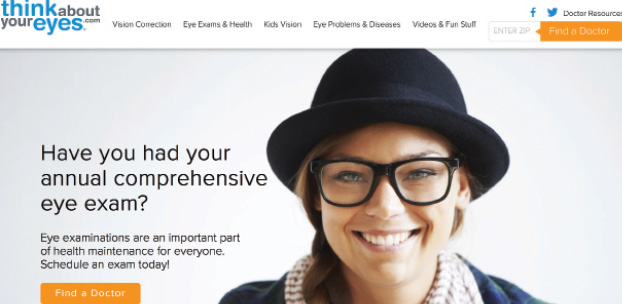
ThinkAboutYourEyes.com
Put together by the American Optometric Association, this attractive website provides a user-friendly library of articles and information that have been verified by medical professionals.
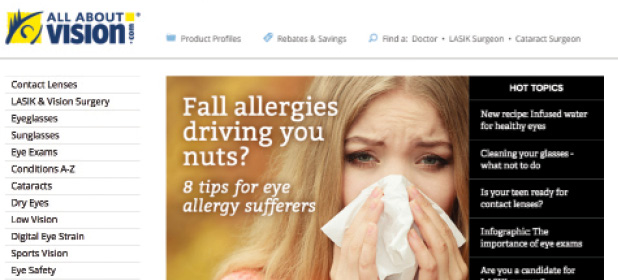
AllAboutVision.com
Online library source of articles and news. This website has been around since 2000, and its longevity is a testament to its utility.

MyEyes.com
Funded by Alcon, this site provides a nice overview of ocular diseases and disorders that patients may have questions about.
Then begins our system of handoffs. If there is a need for eyewear consultation, our optician is called upon to lead the conversation. If a surgical consultation is required, our front office staff does an excellent job scheduling with a surgeon and letting patients know what they can expect as the next step. What I try not to do is overload my patients with too much information. This could end up either confusing them or conflicting with what he or she may learn later from the surgeon.
For the cataract patient, this means providing a starting point about the technology the surgeon may use, but, again, keeping it basic: “You may only be able to see in the distance after surgery and use some kind of reading prescription for close work,” or, “You may be able to have vision that is pretty comfortable at all distances.” Our sense is that overpromising about options could set a patient up with unreasonable expectations. In addition, so many variables go into intraocular lens selections that are best addressed by the surgeon directly. We want to give basic information first. And patients tend to learn more effectively when they are given digestible pieces of information in small doses. Education is cumulative.
We believe our system has other benefits as well. First, when staff members are responsible primarily for one area, they can become much more educated about their focus. It also gives each staff member a stake in the process and a feeling of engagement in the patient’s overall care. Further, this arrangement helps things run more efficiently, as we limit bottlenecks that can occur as a result of protracted patient encounters.
CONCLUSION
Eye care professionals should not be afraid to get back to basics—to present information to patients under the assumption that they know absolutely nothing about the topic under discussion. There may come a time when greater public awareness about the eye and ocular health rises to such a level that we can start with more complicated topics and take a deeper dive into the nuances of the diseases and disorders patients are experiencing. Until that happens, we do a better service in educating patients if we start basic. This means giving them small nuggets of information at a time, taking a team approach to education, and providing them with resources that complement and reinforce the information we provide in the clinic.




